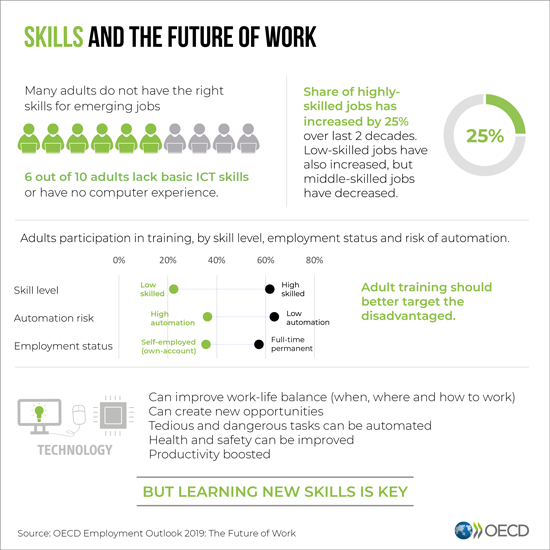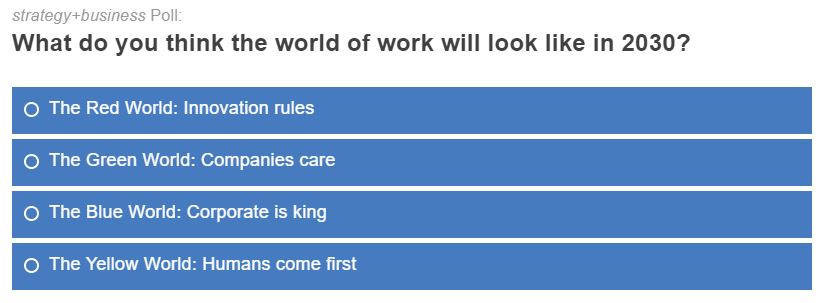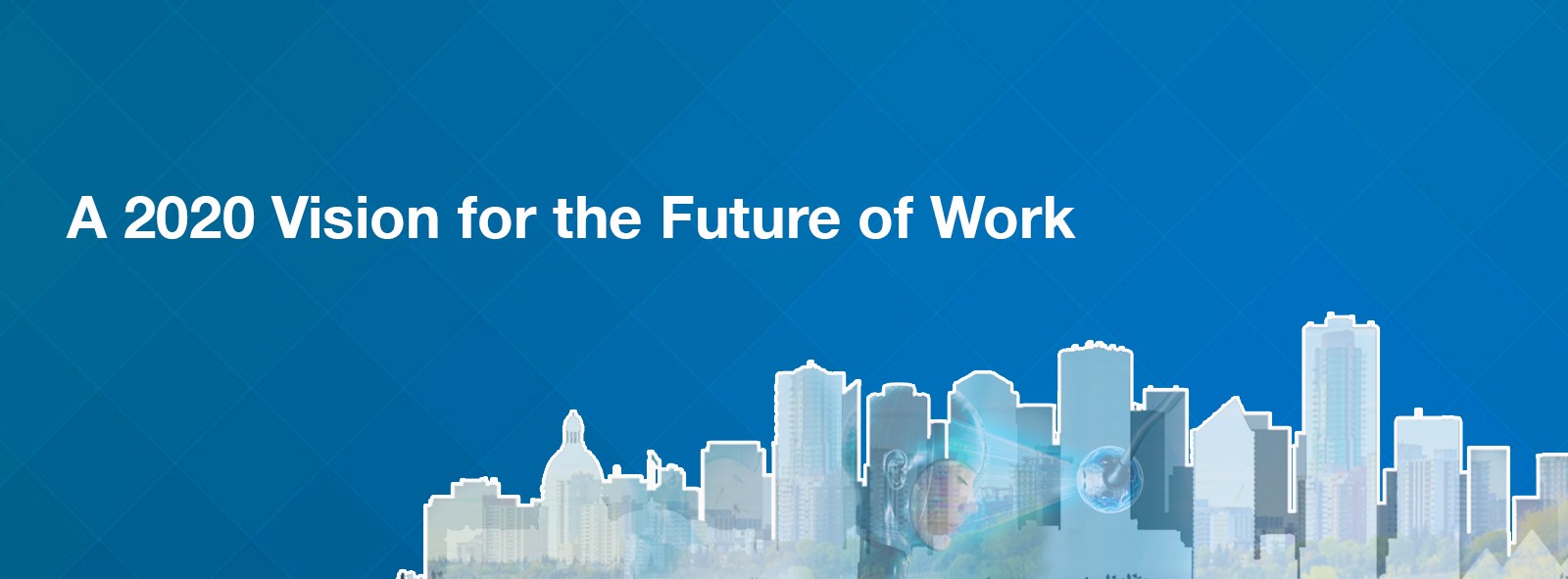Overview of the future of work trends
Let’s recap on the future of work using the most recent OECD statistics. We already know that automation is on the rise, but that on a high skill level, it will only affect between 13-14% of new jobs in the labour force. Manufacturing around the world has decreased by 20% and continues to decline. Within manufacturing, jobs are requiring higher technology skills, sophisticated thinking and problem-solving abilities.
More and more jobs require basic ICT skills and a larger percentage of new jobs involve high skills in technology. According to OECD’s 2019 report, a staggering six out of ten employees around the world have no digital skills and have never even turned on a computer. Over the past two decades the portion of middle-skilled jobs has decreased, while high-skilled jobs have increased by 25%.
Additionally, there is insignificant focus on training and development for the employees who need it most. Take a look at this 2019 OECD graph:

It shows that:
- 20% low skilled workers receive training compared to 60% high skilled workers
- Less than 40% high automation risk workers receive training compared to 63% low automation risk workers
- Less than 40% self-employed individuals pay for their own training compared to almost 60% fully employed individuals who have training provided to them
The last point is significant in an employment context because more employers are hiring part-time and subcontracting in the “gig” economy. More employees are supplementing lower income with self-employment income. And self-employment as a full-time occupation is on the rise. As a result, self-employed individuals are at increased risk because they do not have the means to invest in training that would keep them current, while being at higher risk of low or no social protection.
The service sector on the other hand has risen by 27%. This means that a larger percentage of employees will need advanced people skills than technology . Soft skills like communication with the ability to engage with people and carry on a conversation, emotional self-regulation, staying calm under pressure, managing interpersonal conflicts between customers and employees, ability to cultivate positive, altruistic helpful attitudes and behaviours, and willingness to work collectively towards common goals while detaching emotionally from personal opinions and desires – none of these essential “learning to live together” literacy skills are yet being developed for this increasingly numerous service sector work.
Work worlds of the future
PwC’s future of work experts, Jeff Hesse and Scott Olson have taken the cross-cutting themes from the future of work data and created four different “world of work” potential scenarios. Their four worlds show the direction of work under four different values systems:

In each of their imagined worlds of work, the authors define a primary driver, a people strategy and a workforce ecosystem. Both the red and blue worlds are driven by competition, the green world by cooperation and the yellow world by collaboration. The reality is that most people will experience a combination and variety of these scenarios throughout their work lives. As employers become more conscious of the kind of workforce and environment they have and the force of their own impact, direct implications of their actions will be made visible. An additional consideration of the Hesse and Olsen scenarios is that any one of these workforce “worlds” can be created or destroyed by surrounding environmental contexts, disasters, and governmental choices.
What is interesting about the article is that ideas of environmentally friendly, people-focused workplaces with fair and equitable pay, and creative collective enterprises were never even mentioned in future of work articles before the 2000’s. And although many workplaces continue to exploit and commoditize employees, damage the work location natural environments in which employees live, and refuse to provide basic human rights, an increasing number of workplaces are consciously moving towards happy and productive work environments, ethical decisions and values-based business actions. What you focus on grows, so both types of approaches generate income. The question to ask is which model is more likely to be sustainable in the event of a natural or man-made disaster.
Why survival of the kindest is the way to healthy and happy workplaces
According to research on social development[1], this past decade has denounced the fallacy of the survival of the fittest model and replaced it with the survival of the kindest. Even the so-called originator of the survival theory, Charles Darwin, has been re-read to describe how his discoveries about mammals demonstrated that maternal and social impulses were stronger for the continuation of the species than territorial impulses and fighting. In one example after the other, Darwin describes how mammals who survive and thrive develop sympathy, employ frequent warm physical touches and demonstrate ongoing care for each other.
Modern researchers such as Dacher Keltner and Matthew Hertenstein, found in their studies that kind and sympathetic mammals have more robust immune systems, respond more appropriately danger and have less stress neurons in the brain than aggressive counterparts. In kind mammals, their reproductive systems are more robust and healthy birth rates higher. The Keltner and Hertenstein research showed how humans who responded to a variety of touches to the arm in a controlled research environment, were more accurately able to interpret sympathy, love and gratitude through touch than by random guessing.
The importance of kindness for the future of work is that if we want to survive and thrive, we must focus on the capacity of human beings to care, to create, to love and to help each other. Share on X
Kindness is natural. It is inborn. And it needs to be cultivated and validated for what it is – our key to survival in a volatile world. This discovery has become increasingly necessary in the context of having five generations of employees working together for the first time in history. We have parents of babies, pre-schoolers and teens working along side teens and youth. We have grandparents and great-grandparents working alongside three to four younger generations.
Intergenerational workers, aging workers, productivity and kindness
Along with this intergenerational workforce comes both the benefits of diversity – age diversity - and intergenerational requirements of care. Share on X
The World Economic Forum writes:
We live in a world where people age 60 and over will soon outnumber children aged five and under. Demographers predict that in countries that are ageing well, more than half the children born today will live to 100 – and some researchers believe that the first person who will live to the age of 150 has already been born.
A new term in the intergenerational workforce has emerged as “perennials”. Rather than allowing the massive employment of millennials to dictate workforce policy, the consideration of all generations that incorporate the perennials is emerging.
Even so, Ageism is certainly affecting opportunities for the ranks of workers over age 50. It is commonly believed that older workers are less productive. RAND studies in the US show that an ageing workforce is slowing down the US economy. But maybe the reason for that is because we haven’t figured out how to work effectively across generations.
Putting new employees in situations they don’t have the maturity to deal with, unskilled workers into technological environments they are not trained for, poorly prepared new managers without people skills in charge of groups they don’t understand, and a blind focus on highly skilled individual performers to the detriment of collective capacity building, have not put us into the mindset of properly utilizing older workers.
Why put older workers into positions of high physical demand and fast response requirements? Why not instead have older workers do more mentoring, monitoring, training and use their operational knowledge to avoid unnecessary mistakes? And is growth the only metric for success? Unbounded growth has a name. Cancer. It is natural and desirable for growth to be tempered to suit the development of the market and changing demographics. After all we wouldn’t want children to continue to grow for the rest of their lives, why do we expect production to be on that kind of a train wreck trajectory? I can only think of one reason. Greed. And we have already witnessed the detrimental effects of greed on health and sustainability.
The second consideration is that more and more of the workforce are already taking longer periods off work to care for the very young, the disabled and the elderly. When this happens, there is little social protection for the caregivers who often suffer significant loss of revenue and increased health issues as a result.
The focus on well-being in the workplace is emerging in part from the increasing number of employees having to care for elderly relatives, very young grandchildren and dependent adult children – either independently or in consort. An increasing number of single young adults means less family networks to care for each other when difficulties happen. Add to this the reality that every single one of us will be disabled either short or long term at one or many points in our lives and that many employees over aged 60 work because they must.
All this points to a future of work that must develop a kinder, more inclusive and collaborative approach in order to survive. We will need social nets that allow individuals to care for their family and friends and these will increasingly become part of workforce planning whether we like it or not.
Digital access has created the conception of time as continuous flow rather than as specific blocks or seasons, consequently blurring work and private spaces. Share on X
Boundaries of personal and public are evolving into new social norms. And the previously clear walls between working and taking care of significant others are crumbling.
Conclusions
Workplaces need to plan for care and care giving. Part of that care is to properly train employees to do the jobs required of them. Part of it is to stop insisting that aggression and unbounded growth are the way to solve our current problems. And part of it is a realization that we are only able to have healthy and productive environments when we have warm, kind, inclusive environments in which to work, play and interact. This is the future of work. Without it, there won’t be a future.
About Marie:
Marie Gervais, PhD., CEO of Shift Management Inc., provides managerial training and workforce interpersonal development to business and industry through online courses and web coaching. She helps individuals and organizations build talent and skills for leadership, communication, and conflict resolution particularly at the supervisory and middle management level. Her work has gained a reputation for excellence in integration and inclusion of the diverse workforce. With her team at Shift Management, Dr Gervais helps clients reach their business goals through team building coaching and industry-specific training development for interpersonal leadership skills. Her impactful digital and multi-media resources have been successfully implemented with many different populations and contexts. The results prove that a learning workplace is a happy and profitable one!
Check out Marie’s podcast Culture and Leadership Connections on Apple Podcasts and on the Shift website to hear stories of leadership and all things cultural. Consider the signature Supervisory Leadership Certificate Course for upskilling your workforce at:
https://shiftworkplace.com/courses/supervisory-leadership/
Contact information:
780 993 1062
https://www.linkedin.com/in/leaderstraining/
—————————————————————————————————–
References used in writing this article:








